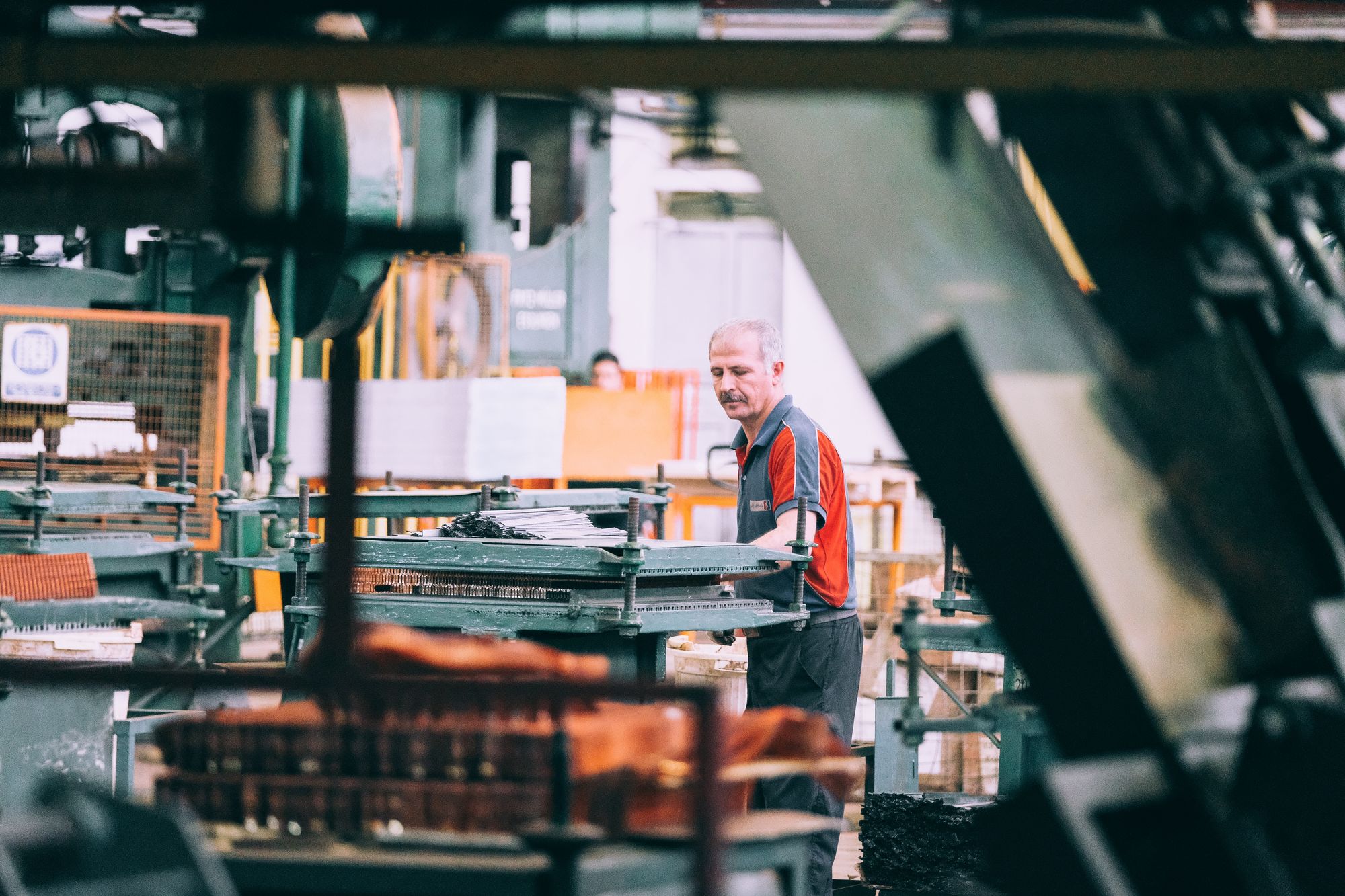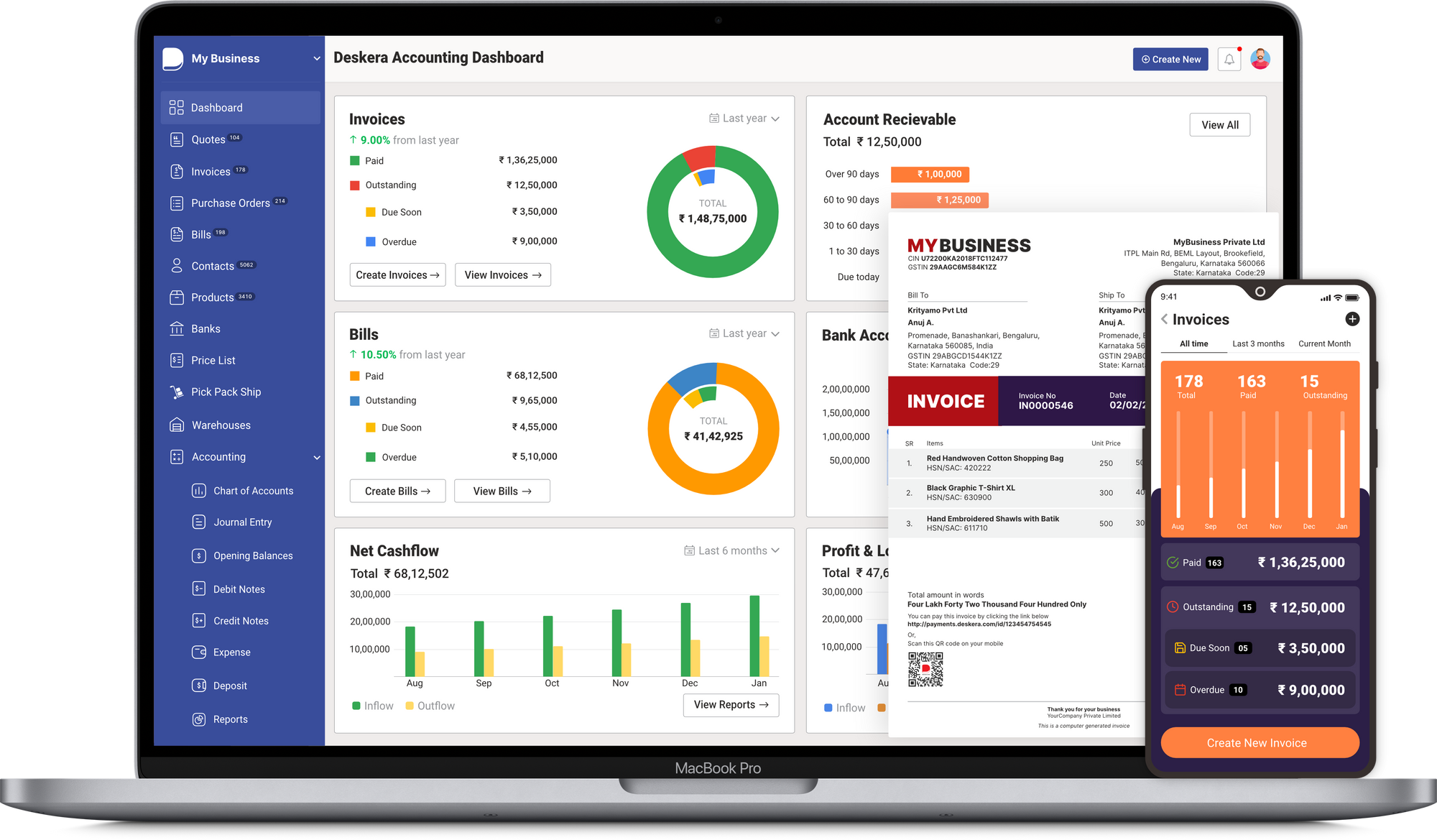As a manufacturer or any business owner, it is essential to maintain a healthy production line. However, with your hands full it can often become a task. This is where shop floor management or shop floor planning comes into play.

Shop floor planning helps you to keep tabs on all the progress at the shop floor level. Let’s learn more about shop floor planning and how you can benefit from it.
This article covers the following:
- What is shop floor planning?
- What is the goal of shop floor management?
- What are the three stages of shop floor management?
- What are the key features of shop floor management?
- What are the major benefits of shop floor management?
- What are the best practices of shop floor management?
- Implementation of 5s on shop floor management.
- How can Deskera assist you?
What is Shop Floor Planning?
A shop floor is a place where production or assembly is done. Either the labor would have to do this manually, or sophisticated automated systems would have to do it. Consequently, shop floor management might be characterized as management at the point of action.
At this location where value is created, managers and production staff gather every day to thoroughly examine the machinery, inventory, storage, and manufacturing processes in order to spot any disruptions or deviations in the value-added processes and, where appropriate, to start corrective action.
These regular gatherings, also referred to as shop floor management meetings are an essential component of management.
What is the Goal of Shop Floor Management?
Here are a few crucial goals for shop floor management:
-Arranging the proper flow of material on the shop floor.
-Putting the on-the-shop floor procedures and processes in order.
-Scheduling of operations, resources, and labor.
-Identifying a divergence from the norm in processes and procedures.
-Identifying communication gaps on the shop floor.
What are the Three Stages of Shop Floor Management?
Shop floor planning concerns the management of your operations planning, inventory, equipment, and workers. Your shop floor planning and control will go through these three phases:
- Order release
- Order scheduling
- Order progress
Phase 1– Order Release
Using shop floor applications, the master production schedule will inform which manufacturing order needs to be generated. Then from there, the order release document will inform the shop floor management boards of the resources and manufacturing processes needed to complete the order.
Phase 2– Order Scheduling
Once the order release has been generated, shop floor applications will schedule the production of the order, while providing you with a detailed workflow of the manufacturing route the order will pass through. The order scheduling phase will explain:
- The workstations the order passes through
- The materials and quantity needed for the order.
This allows managers and employees to understand what needs to be done, who needs to do it, and how it needs to be done.
Phase 3– Order Progress
The shop floor scheduling boards monitor the progress of the manufacturing order and various other manufacturing operations within your business. Giving you breakdowns of
- The entire overview of in-waiting, WIP, and finished manufacturing orders
- Individual orders along the production line
- The employees who are working, about to work, or have worked on an order
What are the Key Features of Shop Floor Management & How it Can Help You to Improve Your Business Processes?
Here are a few features of shop floor planning that make it useful for every business owner.
Production Activity Control
Production activity control in shop floor planning is the process of coordinating your:
- Manufacturing resources
- Productions orders
- Schedules
- Material consumption.
Production activity control is going to be responsible for executing your plans with proper guidance on how to complete production. Shop floor management boards will allow you to analyze which workloads you should prioritize for a workstation and the ideal capacity that a workstation can take before it becomes under or overworked.
Tracking Hours & Quantity
- Enter and track time and quantity completed and quantity scrapped by work order and by the employee.
- Allocate and track resource usage by work center per calendar month.
- Review and analyze work order reports with detailed information when you use standard versus actual values for
- Setup, labor, and machine time.
- Charging actual hours and quantities to a work order as each manufacturing step is completed.
Reporting
- Generate reports that compare actual values with planned values and indicate the variance between the two.
- Generate shortage reports by item or work order to identify potential manufacturing constraints due to a lack of required components.
- Print shop floor paperwork, such as work orders, parts lists, and item routing instructions.
- Review daily work lists to monitor job status, identify queue problems at work centers, and flag other areas, such as engineering changes or lost material.
Tracking of Goods
- Create a parts list automatically when you run the Order Processing program (R31410).
- Attach the parts list, routing instructions to the work order, and print shop floor paperwork.
- Check the availability of the components required to manufacture a parent item and generate a shortage list.
- Issue the parts to a work order using a manual, pre-flush, or backflush method.
- Backflush quantities of components issued to a work order and the labor expended with pay point operations.
- Signal material movement with kanban processing from inventory, work orders, or purchase orders.
- Enter and track completions to inventory when parent items are completed.
- Track where lots are used, and split and trace where lots originate with advanced lot control.
Accounting
- Plan and track costs for setup, labor, material, and overhead.
- Compare planned costs to actual costs and calculate a variance amount.
- Create journal entries in the general ledger to charge actual costs and variance costs to a work order or rate schedule.
- Use feature cost percent for co-product and by-product costing.
Production Scheduling & Tracking
- Schedule work center production for work orders, rate schedules, or both.
- Track and compare planned production schedules with actual schedules.
- Use the online scheduling workbench to review, dispatch, and update production scheduling information in real-time.
- Calculate start and completion dates for each work order by operation.
- Maintain the rate schedule after using rate-based Material Requirements Planning (MRP) or Master Production Scheduling (MPS).
Creating Work Order & Rate Schedule
You use the work order and rate schedule creation features to:
- Enter work orders or rate schedules manually.
- Create work orders and rate schedules automatically from MPS or MRP by answering action messages.
- Create work orders from the Sales Order Entry program, in which you can select kits for assemble-to-order products.
- Generate shop floor paperwork for rate schedules, including standard parts lists and routing instructions.
- Differentiate work orders and rate schedules by type, priority, and status.
- Group work orders by a parent number. For example, you can create job numbers that contain many work order numbers.
- Generate purchase orders for subcontracted operations on the routing instructions for work orders and rate schedules by running the Order Processing program.
Major Benefits of Shop Floor Management
Here are a few benefits of shop floor management that you must take note of:
Easy Flow of Information
The efficient exchange of information can help your company succeed. By handling it appropriately, the software can improve the speed and accuracy of information flow.
The program enables you to get total control over the supply chain and can offer up-to-the-minute analyses. You can also choose which parts of the production line require your attention.
Cost Effective
Legacy and obsolete production systems rely on manually entered data, and therefore, they are not as efficient as advanced technology-based solutions at finding issues.
The shop floor solution can identify the areas where productivity needs improvement. It can save valuable time for project managers by automating the process and enabling them to focus on other core activities. In a way, profitability is increased, and overheads can be decreased.
More Transparency
Real-time data, project intelligence, and details about the supplier chain are all easily accessible. Your staff becomes more devoted to their mission and more effective as a result.
Furthermore, precise corporate data presentation promotes your company's reputation and transparency. Your staff will have no trouble identifying problems and fixing them thanks to the floor management dashboard's plenty of information. Additionally, it drastically cuts down on reaction time.
Accurate Information
The production flow, supply chain management, and other manufacturing units need real-time information to act faster. The shop floor management tracks every step of the production cycle and provides real-time information to make insightful decisions.
More Support for the Teams
The shop floor management wants to offer quick assistance to the teams in different divisions. The solution can provide real-time information and establish seamless communication among concerned executives to resolve the issues soon.
It can help businesses remove the ‘operational blindness’ by enabling various departments to work together. In a way, you can save big on time and operating revenue.
Improved Process
Using shop floor control to uncover ineffective manufacturing processes is one of its key advantages. These areas can be improved by giving your shop floor staff more training or by putting new systems in place to cut expenses and minimize waste.
On the shop floor, it can be challenging to continue process improvement since employees frequently fall back on tried-and-true but less effective procedures. Managers can monitor the state of the production in real time and determine whether procedures are being followed by using shop floor control technologies.
Fewer Mistakes
The right shop floor management allows for the smooth and swift flow of information, with real-time communication achievable by utilizing IIoT solutions. Thanks to swift and transparent communication, the production manager and other key decision-makers can stay up-to-date on the ground operations and have complete control over the supply chain.
As a result, identifying and optimizing any problematic areas becomes a part of the routine, leading to a significant drop in errors and robust execution of standard procedures and processes.
Reduced Waste & Costs
As the production cycles start running smoothly; organizations instantly experience a decline in wastage and overhead and, consequently, an uptick in profitability.
That is made possible thanks to the drop in errors and an overall boost in productivity at each step of production.
Saves Time
Project managers can quickly reach data-backed choices since they have automated access to crucial supply chain data in real-time via a floor management dashboard.
As a result, project managers can focus on other essential tasks while saving significant time. In addition to the improved shop floor management, this inevitably results in an increase in other areas.
Please contact us immediately if you're interested in learning more about how shop floor management can change how your business operates.
Key Performance Indicators
It should go without saying that a successful manufacturing run requires a talented and experienced crew. By using shop floor software, you can inform your staff about performance levels and support additional training for underachievers, increasing productivity.
Paperless Environment-Friendly Approach
The most recent trends and forecasts demonstrate that consumers are more knowledgeable than ever before and prefer to do business with companies that engage in environmentally responsible production. You can create a paperless manufacturing process by using shop floor planning on your production lines since it gives you the ability to:
-Plan your production.
-Track development
-Utilize a computer, tablet, or smartphone to manage your entire business.
What are the Best Practices of Shop Floor Management?
Mentioned below are some of the best practices of shop-floor management:
Generate New Processes
The manufacturing industry is a continuously evolving trade. With that in mind, one of the best practices your business can adopt is the constant need to look for improvement and innovation opportunities.
Better Data Collection
By improving the data collection process of your business, you can significantly boost the productivity and efficiency rate of your manufacturing company. This is because you are more likely to make informed decisions when you have the right and substantial records and data with you.
Having accurate data also allows you to effectively assess and measure the performance of your workforce and production levels. This can then lead to revisiting certain processes and functions that may need improvement.
While a traditional spreadsheet can help tabulate and encode records, automating this aspect of your workflow can help you save time and minimize human errors.
Align SOPs
Standard Operating Procedures, or SOPs, are paramount on the shop floor. It outlines specific guidelines, policies, and procedures needed in the production process. SOPs typically include your company’s standards, health, and safety guidelines, as well as various industry regulations.
This can be an essential tool in your shop floor management system since it elaborates the tasks and responsibilities of your workforce, which can help minimize errors and allow you to maintain the consistent quality of your products.
By establishing and implementing clear SOPs, you can further boost the efficiency and profitability of your business.
Focus on Employee Welfare
In a manufacturing and production setup, aside from the machinery and equipment, the workforce is the critical component that helps ensure that your business is running smoothly.
With that in mind, it’s only important that you value and take care of your staff and their welfare. A team member who feels appreciated and valued tends to feel more motivated.
A well-motivated and inspired employee is more likely to work harder and be able to focus better on their roles and responsibilities, which can then boost the productivity and efficiency of your operations.
More so, this can help increase the chances of retaining employees in your team and may help reduce the levels of absenteeism in your organization. One way you can further boost the morale of your staff is by introducing a reward system.
It’s always recommended to recognize the achievements within your organization. It can help motivate your staff and inspire teamwork amongst your team members.
Skill Development
Skill development is a determinant factor for effective shop floor management. To ensure that your operations are running smoothly and effectively, it’d be ideal to invest in your workforce.
Consider developing a training program to further enhance your team’s skills and capability. By doing this, you can promote career development in your organization while increasing capacity building on the shop floor.
More so, investing in training programs can also allow you to constantly update your processes and align them with the ongoing trends and best practices in the industry.
Implementation of 5S Methodology into Shop Floor Management
The 5S method of visual management is systematic and makes use of everything from floor tape to operations manuals. It's not just about keeping things tidy and organized; it's also about increasing productivity and profit.
The 5S framework places an emphasis on using a particular attitude and set of tools to boost productivity and value. It entails performing waste removal exercises as well as monitoring, evaluating, working together, and searching for garbage.
What is 5s Method?
The 5s in this method might seem vague to begin with, but it will make sense once it is practiced. Let’s find out what these 5s are.
Sort
Going through all the tools, furniture, supplies, equipment, etc., in a workspace to determine what must remain and what may be removed is the first phase of the 5S process, known as sorting.
In case of unwanted resources:
- Give the items to a different department
- Recycle/throw away/sell the items
- Put items into storage
Set in Order
It is simpler to distinguish between things after the extra clutter is gone. The remaining items can now be sorted using the strategies developed by the task groups.
What to consider:
Which people (or workstations) use which items?
When are items used?
Which items are used most frequently?
Should items be grouped by type?
Where would it be most logical to place items?
Would some placements be more ergonomic for workers than others?
Would some placements cut down on unnecessary motion?
Are more storage containers necessary to keep things organized?
Everyone should decide what arrangements make the most sense during this stage. This will necessitate consideration of tasks, their frequency, people's movements through the area, etc.
Shine
Although everyone assumes they understand what housekeeping is, it's one of the things that are most likely to be forgotten, especially when work gets busy. The 5S process' Shine stage is all about sprucing up the workspace, which includes sweeping, mopping, dusting, wiping off surfaces, storing equipment and materials, etc.
Although everyone assumes they understand what housekeeping is, it's one of the things that is most likely to be forgotten, especially when work gets busy. The 5S process' Shine stage is all about sprucing up the workspace, which includes sweeping, mopping, dusting, wiping off surfaces, storing equipment and materials, etc.
Although cleaning the office might not sound interesting, it is crucial. And the janitorial staff shouldn't be the only ones in charge. Everyone in 5S is accountable for keeping their workspace tidy, ideally every day. People will eventually become more invested in their work and the firm since doing this encourages people to take ownership of the environment.
Standardize
After completing the first three phases of 5S; everything should appear to be in good shape. Everything is tidy and organized, the premises have been cleaned, and the equipment is in good operating order.
The issue is that it's simple to clean up and get organized when 5S is first implemented at a company and then let things slowly go back to how they were. 5S distinguishes itself from the traditional spring cleaning project through standardization.
Everything that just transpired is systematized by standardization, which also creates habits out of one-time actions. To make these actions ordinary, standardize assigns regular tasks, makes schedules and displays instructions. It creates 5S standard operating procedures to ensure that cleanliness doesn't suffer.
A chart or a daily 5S checklist may be helpful, depending on the workspace. Another useful tool is a written schedule that specifies who is in charge of which cleaning duties and how frequently they need to be performed.
People will undoubtedly require reminders about 5S at first. Daily time allocation for 5S chores may just need to be a small amount. However, with practice, activities will become automatic, and 5S cleaning and organizing will become routine aspects of work.
Sustain
Businesses must carry out the continuing job of maintaining those procedures and improving them as appropriate after standard 5S procedures are in place. The term "sustain" describes the procedure for maintaining 5S operation as well as for keeping everyone in the organization engaged.
Employees in the office, in the warehouse, and on the production line, all need to participate. Making 5S a long-term program rather than a one-time event or quick endeavor is what sustainability is all about.
5S should ideally become ingrained in an organization's culture. Businesses will begin to realize consistent positive benefits when 5S is maintained over time.
Safety
Safety is a sixth S that some businesses prefer to add to their 5S program. The system is frequently referred to as 6S when safety is added. By organizing things in specific ways, the Safety phase focuses on what can be done to avoid hazards in work processes.
This may entail arranging workstations in a more ergonomic manner, adding signs at crossings (such as those where forklifts and pedestrians cross paths), and labeling the cleaning chemical storage cabinet to alert workers to any potential dangers.
Dangers should be minimized to the greatest extent practicable if the design of the workplace or the jobs people do are hazardous. The sixth S is centered on that. Some people argue that a sixth S is unnecessary because safety may be achieved by following the other five S's correctly.
They believe that a separate safety measure is not necessary if the workstation is well-arranged, well-maintained, and equipped with useful visual safety cues. Both methods of safety are acceptable. But regardless of how a company chooses to approach safety, it should be conscious of how crucial safety is.
How Can Deskera Assist You?
Deskera is an all-in-one solution for modern manufacturers like you who would like to get a grip on their raw materials and finished goods inventory, production planning, or advanced planning scheduling.

Key Takeaways:
- A shop floor is a place where production or assembly is done. Either the labor would have to do this manually, or sophisticated automated systems would have to do it.
- Shop floor planning and control is the process of using methods and tools to track, schedule, and report the status of work-in-progress (WIP) manufacturing from your floor level, giving you a clear channel of communication between your operators and managers on the production line.
- Your shop floor planning and control will go through these three phases, order release, order scheduling, and order progress.
- Shop floor planning enables an efficient exchange of information and can help your company succeed.
- The shop floor solution can identify the areas where productivity needs improvement.
- Using shop floor control to uncover ineffective manufacturing processes is one of its key advantages.
- The shop floor management tracks every step of the production cycle and provides real-time information to make insightful decisions.
- By using shop floor software, you can inform your staff about performance levels and support additional training for underachievers, increasing productivity.
Related Articles:













